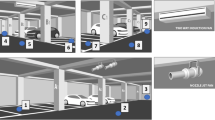Abstract
In general, for a line-up of automobiles waiting for a period of time at a drive-up facility, the idling engine emissions are expelled in a rearward direction and tend to envelope the vehicles at the end portion of the queue. Factors that affect these highly localized pollutant accumulation episodes include local meteorological conditions (low altitude inversions, winds and temperatures), number, age and tune-up condition of the cars, exhaust pipe location, interior air handling equipment, vehicle separation distances and natural or artificial barriers that form troughs or partial enclosures in which vehicular emissions can accumulate or be trapped.
In a series of typical vehicle line-ups, local CO concentrations were measured. With Santa Clara Valley background levels of 2 to 5 ppm, the 15 min average driver-area concentration levels ranged from 15 ppm to 95 ppm with short term peaks between 100 and 1000 ppm. Wide variations in concentrations can be expected if ventilating fans for heater or air conditioner units are also operating.
The exposure of humans to these concentrations of CO can result in mild headache or nausea, failure to react quickly to stimuli (like oncoming traffic) as well as setting a strain on the heart and lungs. These effects are temporary and reversible. A far more serious local air quality and health problem arises in the growing production of SOx and sulfate compounds attributable to the legislated use of oxidizing catalytic mufflers for new car emission control and oxidation of the elemental S found in all gasoline. Using the CO levels as indicators of the accumulation of local automobile produced pollutants, when a majority of cars are equipped with catalytic converters, the anticipated adverse effects of SOx concentrations, irritation and inflammation of healthy lung tissue of young and old people alike, as well as aggravation of preexisting conditions of lung or heart impairment, will be a most undesirable feature of drive-up facility services.
Potential reductions in the extent of this developing problem include S removal, SOx traps and exhaust sustem redesign.
Similar content being viewed by others
References
Rossin, A. D. and Roberts, J. J.: 1972, ‘Episode Control Criteria and Strategy for Carbon Monoxide’, J. Air Pollut. Control Assoc.
Stewart, R. D., Peterson, J. E., Baretta, E. D., Bachand, R. T., Hosko, M. J., and Herrman, A. A.: 1970, Arch. Environ. Health 21.
Lewis, T. R., Moorman, W. J., Yang, Y., and Stara, J. F.: 1974, Arch. Environ. Health 29, 102.
Senda, T. and Kawamuri, M.: 1974, Japan J. Public Health 21.
Kerrbijn, K. F., Mourmans, A. R. M., and Biersteker, K.: 1975, J. Environment. Res. 10.
U.S. Environmental Protection Agency, Issue Paper: 1975, ‘Estimated Public Health Impact as a Result of Equipping Light-Duty Motor Vehicles with Oxidation Catalysts’, January 30.
Begeman, C. R., Jackson, M. W., and Nebel, G. J.: 1974, ‘Sulfate Emissions from Catalyst-Equipped Automobiles’, SAE paper #741060, General Motors Corporation, October. Pierson, W. R., Hammerle, R. H., and Kummer, J. T.: 1974, ‘Sulfuric Acid Aerosol Emissions from Catalyst-Equipped Engines’, SAE paper #740287, Ford Motor Company, March.
‘Health Consequences of Sulfur Oxides’, A Report from CHESS 1970–76, Human Studies Laboratory, National Environmental Research Center, EPA Research Triangle Park, North Carolina, May 1974.
‘Advisory Report on the Health Implications of the Catalytic Converter, Environment of Health Resource Center, Chicago, NTIS PBE241610, February 1975.
California Air Resources Board, ‘Sources and Effects of Sulfates in the Atmosphere’, An Informational Report, March 6, 1975.
Fulwider, W. E., of Gray and Rogers, Inc., for Manufacturers of Emission Controls Association, ‘MECA Says Its New Analysis Supercedes EPA Sulfate Study’, May 15, 1975.
‘The Changing Challenge’, General Motors Quarterly 3 (1976).
Proceedings of a Conference on Air Quality Impact Analysis for Application in Land Use and Transportation Planning, U.C., Berkeley, June 1974.
‘Guidelines for Air Quality Impact Analysis for Land Use Project’, Bay Area Air Pollution Control District, June 1975.
California Air Resources Board Bulletin, Volume 6, Number 3, March/April 1975.
Author information
Authors and Affiliations
Rights and permissions
About this article
Cite this article
Myronuk, D.J. Augmented ingestion of carbon monoxide and sulfur oxides by occupants of vehicles while idling in drive-up facility lines. Water Air Soil Pollut 7, 203–213 (1977). https://doi.org/10.1007/BF00280861
Received:
Issue Date:
DOI: https://doi.org/10.1007/BF00280861




